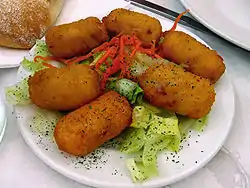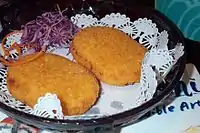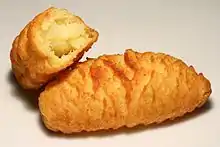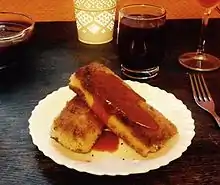Croquette
A croquette (/kroʊˈkɛt/)[1] is a small cylinder of food consisting of a thick binder combined with a filling, which is breaded and deep-fried,[2] and served as a side dish, a snack, or fast food worldwide.
 Cylindrical croquettes | |
| Main ingredients | Ground meat, shellfish, fish, ham, cheese, mashed potatoes, vegetables, béchamel or brown sauce |
|---|---|
The binder is typically a thick béchamel or brown sauce, mashed potatoes,[3] wheat flour or wheat bread.[4] The binder may be mixed with a filling or may be stuffed with it; this mixture is called a salpicon. Typical fillings include finely chopped meat, seafood, cheese, rice, pasta, or various vegetables as well as seasonings such as spices, herbs, and mushrooms. Sweet croquettes may use a pastry cream binder and be filled with fruit.[5][6][7]
Croquettes may also be formed in other shapes: disks, ovals, balls.
Etymology
The word croquette is French, derived from croquer 'to crunch'.[8] In the 18th century, it was usually spelled croquet.[7]
Origins
A 17th-century recipe for croquettes (croquets) by François Massialot binds a filling of meat, truffles, marrow, bread crumbs, and cheese with egg, then breads and fries them in lard. They may be as large as an egg or as a walnut, and can be served as an hors-d'œuvre or as a garnish.[9] They are mentioned in a 1706 English dictionary.[7][10] One 18th-century recipe uses just a batter, not a béchamel binder.[11] Croquettes of the modern type, with a thick binder, are documented in an 1822 English cookbook by the French cook Louis Eustache Ude.[12]
Asia
 Circular croquettes
Circular croquettes Cylindrical potato croquettes
Cylindrical potato croquettes Croquetas fritas
Croquetas fritas Two Dutch kroketten, one cut open to show the beef-ragout filling; Chiang Mai, Thailand
Two Dutch kroketten, one cut open to show the beef-ragout filling; Chiang Mai, Thailand
Indian subcontinent
A potato-filled croquette called aloo tikki,[13] which originated in the Indian subcontinent, is very popular in northern India and is typically served with a stew. They are mostly eaten as snacks at home and are also popularly sold by road-side vendors. In West Bengal, it is called vegetable chop. Sometimes it is called a "cutlet" and eaten plain or as a fast-food variation that is served inside a hamburger bun (like a vegetarian burger). Meat croquettes called kababs are made with minced mutton. Lightly spiced beef croquettes are a popular snack and appetiser among the Christian communities in Goa and Kerala.[14]
China and Taiwan
In China and Taiwan, croquette is called kělè bǐng (芋泥可樂餅). Typically they are made with mashed potatoes and corn.
Indonesia
The kroket[15] (Dutch) made of mashed potato filled with minced chicken or ragout is one of the most popular snack items in Indonesia, introduced during the Dutch colonial rule.[16] The kroket is made by putting chicken filling inside a mashed potato ball which is then breaded and fried.
Japan
A relative of the croquette, known as korokke,[17] (コロッケ) is a very popular fried food, widely available in supermarkets, convenience stores and butcher shops, as well as from specialty korokke shops. [18] Generally patty-shaped, it is mainly made of potatoes with some other ingredients such as vegetables (such as onions and carrots) and maybe less than 5% meat (e.g. pork or beef). It is often served with tonkatsu (とんかつ) sauce. Cylinder-shaped korokke are also served which more closely resemble the French version, where seafood (prawns or crab meat) or chicken in white sauce (ragout) is cooled down to make it harden before the croquette is breaded and deep-fried. When it is served hot, the inside melts. This version is called "cream korokke" (クリームコロッケ) to distinguish it from the potato-based variety. It is often served with no sauce or tomato sauce. Unlike its French cousin, croquettes made mainly of meat are not called korokke in Japan. They are called menchi katsu (メンチカツ), short for minced meat cutlets.
South Korea
Usually called goroke (고로케) or keuroket (크로켓),[19] it is a food sold in most bread shops in Korea. The most common type is deep-fried rolls stuffed with japchae (잡채) ingredients or chicken curry and mashed potato with vegetable salad. Also, goroke are sometimes filled with kimchi, pork, and bulgogi ingredients. Many Korean stores often advertise the goroke as a French product and they are usually sold in most European-style bread stores all over Korea.
Europe
Belgium
Kroketten/croquettes are served as a side dish or as a main dish. They are usually of the savoury variety, filled with mashed potatoes. The two most popular traditional Belgian croquettes have a thick and creamy bechamel filling mixed with grey shrimps "garnaalkroketten/croquettes de crevettes" or cheese "kaaskroketten/croquettes de fromage". As a main dish they are usually served with a salad, fried parsley and frites.
France
The ragout-filled dish was regarded as a French cuisine delicacy, first described in a recipe from 1691 by the chef of the French king Louis XIV, using ingredients such as truffles, sweetbreads, and cream cheese.[20] From the 1800s onwards, it became a way to use up leftover stewed meat.
Germany, Austria, and Switzerland

Plain potato croquettes[21] are served as a side dish in restaurants and are also available frozen in supermarkets. They are usually called Kroketten (singular Krokette).
Hungary
Krokett is a small cylindrical croquette similar to the Czech variety: potatoes, eggs, flour, and butter, seasoned with nutmeg and salt and deep-fried in oil. This variety can be ordered in most restaurants as a side dish, and also bought frozen. When made with cottage cheese, they are called túrókrokett.[22]
Italy
In Italy, crocchette (known in the South as crocchè) are made mainly with crushed potatoes or vegetables, like aubergines (crocchette di melanzane). Rice arancini (typical of Sicily), supplì (Roman cuisine) and Milanese rice and saffron croquettes are particularly well known in Italian cuisine. In Emilia Romagna and Piemonte croquettes are usually filled with chicken meat, while in Calabria polpette di riso are stuffed with rice and cheese (usually Parmesan or Pecorino).
Ireland
Plain potato croquettes are available frozen or refrigerated in most supermarkets. They are also homemade, usually with the addition of chopped onion.
The Netherlands

After World War II, several suppliers started mass-producing croquettes[23] filled with beef. The croquette (kroket in Dutch) subsequently became even more popular as a fast food; meat ragout covered in breadcrumbs subsequently deep-fried. Its success as a fast food garnered its reputation as a cheap dish of dubious quality, to such an extent that Dutch tongue in cheek urban myths relate its "allegedly mysterious content" to offal and butchering waste.[24] Research in 2008 showed that 350 million kroketten are eaten in the Netherlands every year. An estimated 75% of all Dutch people eat them, resulting in 29 kroketten per person per year on average, being the 2nd most popular Dutch snack after the frikandel. The major consumers are between 35 and 49 years old.[25]
The success of the croquette led to a whole series of food products resembling the croquette, but with other types of fillings, such as noodles, rice and kidney, and with names like bamibal, nasibal, and nierbroodje instead of croquette. Variants of the croquette which specify the kind of meat can also be found, like rundvleeskroket (made with beef) and kalfsvleeskroket (made with veal). Also popular in Dutch snack bars are the satékroket (where the filling consists of a peanut satay sauce and shredded meat in a ragout) and the goulashkroket. A smaller round version of the standard beef or veal croquette, the bitterbal,[23] is often served with mustard as a snack in bars and at receptions. Potato croquettes and potato balls (similar to potato croquettes, but small and round) can be bought frozen in most food stores.
Broodje kroket, a croquette on a bread roll, is sold in restaurants, snack shops, and even by street vendors. The popularity of the kroket in the Netherlands is such that even McDonald's sells their version on a bun as "McKroket".[26]
Poland

Croquettes in Poland are typically made from a thin, rolled crepe-type pancake stuffed with meat, mushrooms, cabbage, sauerkraut, or some combinations of those ingredients. The croquette is lightly pan fried before serving.[27] Some recipe variations also require the croquette to be covered in breadcrumbs before frying, and served with a clear soup e.g. "barszcz", similar to borscht.[28]
Portugal
Croquetes[29] are cylindrical, covered in breadcrumbs, and deep-fried. They are usually made with white sauce and beef, sometimes mixed with varying amounts of pork, and frequently with some chouriço, black pepper or piri-piri to add more flavour. Seafood, fish (other than codfish) and vegetarian (potato) croquetes are also eaten in Portugal, but those have other names (such as rissol, pastel, empada), thus the name croquete refers only to the Dutch-style beef croquette.
Russia
The widespread minced cutlet (Russian: котлета рубленная, romanized: kotleta rublennaya)[30] is made of minced meat (beef or pork or mixture of both, chicken, turkey, or fish), bread, eggs, white onions, salt and spices, shaped as a meat patty and pan fried. Bread is added in amount up to 25% of meat, adding softness to the final product and also making it cheaper to produce. The Pozharsky cutlet is a well-known variety of such cutlets in which minced meat is mixed with butter.
Spain
Traditional croquetas[31] in Spain are made with thick béchamel. They are one of the most typical tapas dishes, especially filled with jamón, chicken or saltcod. Also, many bars and restaurants may offer novel, less traditional versions of croquettes with more varied fillings and ingredients such as apple, wild mushrooms, morcilla (blood sausage), cheeses, tuna,[32] cuttlefish (using its ink to give color and flavour), etc. Croqueterías are restaurants that specialize in croquetas.
Caribbean
Puerto Rico
Croquettes are typically made out of ham, codfish or chicken[35] in Puerto Rico, where they are dipped in what is colloquially known as "mayo-ketchup", a variation of fry sauce. Frozen croquettes are sold in supermarkets in Puerto Rico.
Cuba
Cuban croquettes are nearly identical to the Puerto Rican croquettes that are typically made out of ham or chicken.[36] There is a common cheese and potato variation, and they are sometimes made with fish.
Dominican Republic
Dominican croquettes are nearly identical to the Cuban croquettes that are typically made out of ham or chicken, but there is a common cheese and potato variation, a beef variation and they are also sometimes made with fish.
Aruba
Aruban croquettes are more commonly made out of mashed potato, ground beef, shellfish, and fish. They are eaten as an early morning breakfast or as snacks any time of the day. They are considered as one of the island's cultural foods.
North America
Mexico
Croquettes are usually made of tuna or chicken[37] and potatoes. In southern Mexico, a variety is made with fresh cheese, plantain, and black beans.
United States
"Boardwalk" fish cakes and crab cakes, eaten on the east coast of the United States, are essentially croquettes. They consist, respectively, of chopped fish or crab meat, mixed in a buttery dough which is then breaded and deep-fried.
A deviled crab (croqueta de jaiba) is a particular variety of a blue crab croquette from Tampa, Florida. The crab meat is seasoned with a unique Cuban-style enchilada or sofrito sauce (locally known as chilau[38]), breaded with stale Cuban bread crumbs, formed into the approximate shape of a prolate spheroid, and fried. It is meant to be eaten with one hand. It originated in the immigrant community of Ybor City during a cigar workers' strike in the 1920s[39][40][41] and is still very popular in the area.
Other types of crab and fish croquettes are made throughout the southern U.S., especially in coastal states such as Louisiana where seafood dishes are common staples. These varieties have different seasonings and shapes, with some served inside the scooped-out shell of the crab.
A traditional New England/Northeastern United States preparation uses ham, usually of the maple-cured variety, along with cooked mashed potato (often mixed with some mild seasonings and milk or butter for a smoother consistency) for the outer roll. These are dipped in crumbed breading, and sautéed or fried in a small skillet using butter. Typically, these are most common during the Thanksgiving-to-Christmas holiday season as one of several ways to use up leftover holiday ham.
Another croquette dish popular across much of the American South is salmon croquettes. Any canned fish - usually salmon or mackerel, although canned tuna is also used in some recipes (although the dish is often colloquially referred to as "salmon croquettes" or "salmon patties" regardless of the actual fish used) - is mashed by hand to break up any fish bones and give the fish meat a smoother consistency, then combined with a binder and various seasonings. Seasonings typically include pepper, salt, chopped (sometimes sautéed) onions, garlic, lemon juice or paprika. The binder can be any starch such as flour, cornmeal, ground crackers of any type, even white rice, matzo meal, or oatmeal - although these latter variations are not as common, and are mostly limited to the northern U.S. Chopped eggs, parsley, and Parmesan cheese may also be added. The mixture is then shaped into rounded patties for pan- or deep-frying; corn or peanut oil are the most commonly used frying oils in the southern U.S., but canola, safflower, or olive oil are also used, and some recipes call specifically for pan-frying in butter or margarine.
South America
Brazil
Croquetes,[42] primarily made from beef, are a common snack in many parts of Brazil.[43] The coxinha is a popular chicken-based croquette, intentionally shaped to look like a chicken thigh.
Ecuador
From Riobamba llapingachos are potato cakes with a cheese filling, fried in oil with achiote and served with a peanut sauce.
Uruguay
Called "croquetas" in Spanish, the most popular stuffings are mashed potatoes (croquetas de papa), ham and mozzarella cheese (croquetas de jamón y queso), and rice (croquetas de arroz). Sometimes, the rice ones have herbs and little ham cubes. Generally, their shape is cylindrical and they're medium-sized, but larger, spherical ones also can be seen (specially with rice stuffing). They are deep-fried in oil.
The average Uruguayan eats them usually with mayonnaise or ketchup. Croquetas are very common: they can be bought in almost every bakery, supermarket or food shop, and a lot of people cook them at home as a side dish or even main dish. In modern restaurants, more sophisticated croquettes (e.g. with serrano ham and mixture of cheeses, or with salmon) usually come with a more elaborated sauce as dip (e.g. sweet chili sauce), and are ordered as starters (reason why those ones tend to be smaller in size).
Colombia
In Colombia croquettes are commonly referred to as "papa rellena", which translates as stuffed potato. They consist of a mix of roughly mashed potato, seasoned shredded or ground beef and an egg to bind the mix, which is then lightly battered and deep fried. They are served in bars and casual restaurants, as well as often being served at home for a celebration or party. They are usually served with a side of homemade or bottled chilli sauce.
See also
- Cuchifritos – Various fried foods prepared principally of pork
- Bitterballen
- Fritter – Fried pastry usually consisting of a portion of batter with a filling
- List of deep fried foods – Wikipedia list article
- List of potato dishes – Wikipedia list article
- Rissole
- Chicken Cordon Bleu
Notes
- "croquette noun - Definition, pictures, pronunciation and usage notes - Oxford Advanced Learner's Dictionary at OxfordLearnersDictionaries.com". www.oxfordlearnersdictionaries.com.
- Nagao, Keiko; Hatae, Keiko; Shimada, Atsuko (1997). "OCCURRENCE OF RUPTURES ON THE SURFACE OF FOODS DURING FRYING". Journal of Texture Studies. 28 (1): 27–46. doi:10.1111/j.1745-4603.1997.tb00100.x. ISSN 0022-4901.
- Kashima, Tomoko; Masumoto, Shimpei; Ishii, Hiroaki (2009). "Evaluation of Menu Planning Capability Based on Multi-dimensional 0/1 Knapsack Problem of Nutritional Management System". IAENG International Journal of Applied Mathematics. 39: 163–170.
- Khaustova, Tetyana; Fedak, Natalia; Andreeva, Svetlana; Dikhtyar, Aliona (2018-12-10). "Studying the influence of hydrothermal treatment parameters on the properties of wheat flour in the technology of a croquette mass". Eastern-European Journal of Enterprise Technologies. 6 (11 (96)): 77–82. doi:10.15587/1729-4061.2018.150072. ISSN 1729-4061.
- Prosper Montagné, Larousse gastronomique: the encyclopedia of food, wine & cookery, Crown, 1961. (translation of the 1938 edition) OCLC 413918, s.v., p. 325
- "Eat word croquettes".
- Alan Davidson, Oxford Companion to Food, 1999, s.v., p. 229
- Lembi, Dante P.; Kaulfers, Walter V. (1940). "French Expressions Used in English: An Exploratory Vocabulary Unit for the First Week of Beginning French or General Language". The Modern Language Journal. 25 (3): 174–180. doi:10.1111/j.1540-4781.1940.tb00635.x.
- François Massialot, Le Cuisinier royal et bourgeois, Paris, 1693, p. 227
- Edward Phillips, The New World of Words: or, Universal English Dictionary, 7th ed., London 1720, s.v.
- Menon (pseud.), La cuisinière bourgeoise, 1769, p. 42
- Louis Eustache Ude, The French Cook, 1822, p. 208
- "Stuffed Aloo Tikki Recipe - How To Make Stuffed Alu Tikki". indianfoodforever.com.
- Goan croquettes recipe Archived 2011-07-30 at the Wayback Machine
- "Resep Kroket". masakan indonesia.
- Yusuf, Munif (2018-06-29). "INDONESIAN INFLUENCE IN DUTCH: A CULTURAL AND LINGUISTIC PERSPECTIVE". International Review of Humanities Studies. 1 (1). doi:10.7454/irhs.v1i1.50. ISSN 2477-6866.
- Hara, Reiko (2006) International Cuisine: Japan ISBN 0-340-90577-8.
- Palmer, Edwina (2016-01-01). Harima Fudoki: A Record of Ancient Japan Reinterpreted, Translated, Annotated, and with Commentary. BRILL. doi:10.1163/9789004269378_004. ISBN 978-90-04-26937-8.
- KBS, Busan (2005) Archived 2012-07-08 at Archive.today
- "Archived copy". Archived from the original on 2012-02-10. Retrieved 2012-06-18.CS1 maint: archived copy as title (link)
- "Kroketten". ESSEN UND TRINKEN.
- Turokrokett Archived 2008-10-04 at the Wayback Machine
- "Real Dutch kroket and bitterbal". coquinaria.nl. 9 January 2006.
- H. van Dam: Het volkomen krokettenboek, publisher: Nigh & Van Ditmar, 2011
- "Nederland neemt een betere kroket - Foodlog". foodlog.nl.
- "Beyond 'Royale with Cheese' - McKroket (3) - FORTUNE". money.cnn.com. Archived from the original on 2012-10-12. Retrieved 2013-11-19.
- "Recipe - Polish Croquettes". foodcult.com.
- "Krokiet (Croquette- fried breaded meat-filled crepe pancake)". polishfoodrecipes.blogspot.com.
- Alves, Jose. "Receitas - Croquetes de Batata - Roteiro Gastronómico de Portugal". www.gastronomias.com.
- russianfoods Archived 2009-02-10 at the Wayback Machine
- Schneider, Edward. "Making Spanish Croquettes". nytimes.com.
- "Receta de Croquetas de atún fritas". recetasgratis.net.
- croquette
- "Morrison's own label potato croquettes receive top British Frozen Food Award". allbusiness.com.
- "Ham Croquettes". thelatinkitchen.com.
- Peláez, Ana Sofía; Silverman, Ellen. The Cuban table : a celebration of food, flavors, and history (First ed.). New York. ISBN 978-1-250-03608-7. OCLC 883510935.
- "Croquetas de pollo (Mexikanska kycklingkroketter)". matklubben.se.
- "Deviled crab croquettes a tasty Tampa tradition - TBO.com". tbo.com. Archived from the original on 2012-10-09. Retrieved 2011-07-02.
- "Bitter Strikes Brought Deviled Crabs" - Cigar City Magazine Archived 2012-07-22 at Archive.today
- "A venerable Tampa tradition" - foodmuseum.com Archived 2008-05-12 at the Wayback Machine
- Edge, John T. (26 April 2011). "Tampa's Favorite Street Food: Devil Crabs" – via NYTimes.com.
- Araujo, Marina Campos; Cunha, Diana Barbosa; Bezerra, Ilana Nogueira; de Castro, Maria Beatriz Trindade; Sichieri, Rosely (2017). "Quality of food choices of Brazilian adolescents according to individual earnings". Public Health Nutrition. 20 (17): 3145–3150. doi:10.1017/S1368980017002099. ISSN 1368-9800.
External links
| Wikimedia Commons has media related to Croquettes. |
| Look up croquette in Wiktionary, the free dictionary. |
